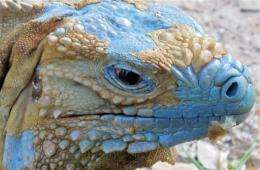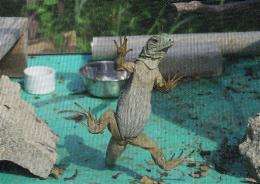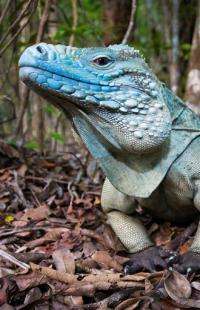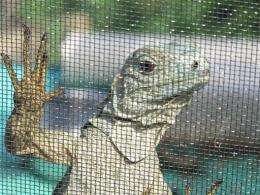Cayman's imperiled blue iguanas on the rebound

(AP) — The blue iguana has lived on the rocky shores of Grand Cayman for at least a couple of million years, preening like a miniature turquoise dragon as it soaked in the sun or sheltered inside crevices. Yet having survived everything from tropical hurricanes to ice ages, it was driven to near-extinction by dogs, cats and cars.
Now, though, a breeding program some see as a global model has worked better than any had hoped to dream for a species that numbered less than a dozen in the wild just a decade ago, preyed upon by escaped pets and struggling to survive in a habitat eroded by the advance of human settlement.
Roughly 700 blazing blue iguanas breed and roam free in protected woodlands on the eastern side of Grand Cayman, a 22-mile-long (35-kilometer-long) speck in the western Caribbean that is the only place where the critically endangered animals are found in the wild.
"The kind of results that we've gotten show that it's practical and realistic to say you can restore a population of iguanas from practically nothing, just so long as you can capture the genetic variety from the beginning," said Fred Burton, the unsalaried director of the Blue Iguana Recovery Program, a partnership linking the islands' National Trust to local and overseas agencies and groups.
In a corner of the Queen Elizabeth II Botanic Park, the "founders," or genetically diverse, wild iguanas captured for the breeding program, mate when the mood strikes in 40-foot-wide pens featuring the rocks, shrubs and trees of their natural habitat. One couple, dubbed "Mad Max" and "Biter," are free to roam outside the pens, scampering after ripened noni, a pungent, potato-sized fruit.

On a recent day at the 65-acre garden and woodland preserve, the adult iguanas were shedding skin, which resembles thin, dry paper, revealing a brilliant turquoise underneath. The primarily herbivorous creatures, which have crimson eyes, grow to roughly five feet (1.5 meters) long, weigh over 25 pounds and are at their bluest when they get excited.
Near the breeding pens, wood-and-wire cages hold the founders' young descendants, which are outfitted with transponder tags embedded beneath their skin. The iguanas are only released into the botanical park and the 625-acre (253-hectare) Salina Reserve after they reach two years of age and are big enough to defend themselves from rats, snakes and most feral cats.
Burton and others concluded in 2001 that young blue iguanas should be released into the wild next to rough-hewn wooden shelters with tight passageways that mimic the rock holes and tree cavities where they naturally shelter from predators. The first year of that experiment, 100 percent of the young survived.

"When we started, we didn't know anything, so for years we just let the iguanas loose and we'd never see half of them again. A year after we came up with this very low-tech method of anchoring iguanas to the park, we found all of them were still living," Burton said, adding that young iguanas soon outgrow the wooden shelters and hardwired behavior kicks in, driving them to make homes without any assistance
Arthur C. Echternacht, a professor of ecology and evolutionary biology at the University of Tennessee, said the Grand Cayman program has succeeded by building unusually strong relationships with international scientists as well as support from local politicians and citizens. He also credits the tenacity and organization of Burton, a soft-spoken man who has been a steward of the Cayman Islands' environment since he moved to the U.K. Caribbean territory in 1979.
"Although Fred can seem to be a rather low-key, unexcitable Brit, he is passionate about the iguanas, very persuasive, and incredibly persistent," Echternacht said in an email.
Early on, Burton sought and received the assistance of international conservation groups, zoos and businesses in the effort. Financing and expertise, including veterinary support from the organizations has furthered the program's success.
John Binns, of the Tucson, Arizona-based International Reptile Conservation Foundation, said the basic infrastructure and steady focus of the Blue Iguana Breeding Program is "really a model on how to correctly restore a species year after year."

When the program started in 1990, most Caymanians didn't even realize that the island was home to an imperiled reptile species. Confusing matters, invasive green iguanas, escapees from the pet trade, are flourishing in Grand Cayman and can be seen across the island.
Now, with growing pride in the blue iguana's rebound, the reptile has inspired stuffed toys, bobblehead dolls and other souvenirs. Visitors landing at the airport are greeted by a poster showing a blue iguana with the words: "His ancestors have been here for 2 million years." A blue iguana dubbed "Gorgeous George" graces the cover of the island's phone book, while tourists go on blue iguana "safaris."
But not all has been smooth sailing for the breeding program. In May 2008, about a half-dozen blue iguanas were killed in their pens, prompting a police investigation that netted no suspects. The iguanas were found stomped and gouged, and Burton said humans, possibly with a pet dog, were almost certainly behind the massacre. Two females had been preparing to lay eggs to help the species repopulate.
Burton said it was an "acid reminder" that not everything could go the program's way, even while it enjoyed broad support among most Caymanians. To protect the iguanas, the breeding pens are now ringed by a fence and barbed wire.
Other researchers have been able to breed captive blue iguanas far from their native environment, though they cannot match the success of the program at home. The overseas program is partly a hedge to make sure the imperiled reptile's genetic footprint survives any calamity.
Nearly 50 adult and juvenile blue iguanas live in 14 U.S. zoos and aquariums, which are considered partners of the breeding program, according to Tandora Grant, of the San Diego Zoo Institute for Conservation Research. Ten more hatchlings are due to be born soon, she said. In Europe, two blue iguanas live in the Prague Zoo in the Czech Republic.
Nonetheless, the key to restoring the endangered species remains in its native habitat of Grand Cayman, where Burton hopes to have 1,000 blue iguanas living in the wild, perhaps as early as 2015.
"Once we hit 1,000 and we have a good genetic range out there we can just let the iguanas handle things themselves out in the wild without us messing around with all this complex genetic planning," Burton said at the park.
Gesturing at the breeding pens, Burton said: "Soon this will all be redundant, and that will be a very exciting day."
Copyright 2012 The Associated Press. All rights reserved. This material may not be published, broadcast, rewritten or redistributed.



















